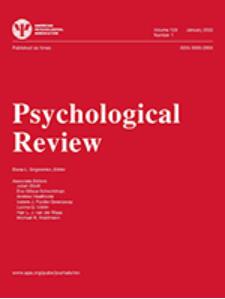Is visual perception WEIRD? The Müller-Lyer illusion and the cultural byproduct hypothesis.
IF 5.8
1区 心理学
Q1 PSYCHOLOGY
引用次数: 0
Abstract
A fundamental question in the psychological sciences is the degree to which culture shapes core cognitive processes-perhaps none more foundational than how we perceive the world around us. A dramatic and oft-cited "case study" of culture's power in this regard is the Müller-Lyer illusion, which depicts two lines of equal length but with arrowheads pointing either inward or outward, creating the illusion that one line is longer than the other. According to a line of research stretching back over a century, depending on the society you were raised in (and how much carpentry you were exposed to), you may not see the illusion at all-an ambitious and influential research program motivating claims that seemingly basic aspects of visual processing may actually be "culturally evolved byproducts." This cultural byproduct hypothesis bears on foundational issues in the science, philosophy, and sociology of psychology, and remains popular today. Yet, here we argue that it is almost certainly false. We synthesize evidence from diverse fields which demonstrate that (a) the illusion is not limited to humans, appearing in nonhuman animals from diverse ecologies; (b) the statistics of natural scenes are sufficient to capture the illusion; (c) the illusion does not require straight lines typical of carpentry (nor even any lines at all); (d) the illusion arises in sense modalities other than vision; and (e) the illusion arises even in congenitally blind subjects. Moreover, by reexamining historical data and ethnographic descriptions from the original case studies, we show that the evidence for cultural variation and its correlation with key cultural variables is in fact highly inconsistent, beset by questionable research practices, and misreported by later discussions. Together, these considerations undermine the most popular and dramatic example of cultural influence on perception. We further extend our case beyond this phenomenon, showing that many of these considerations apply to other visual illusions as well, including similarly implicated visual phenomena such as the Ebbinghaus, Ponzo, Poggendorf, and horizontal-vertical illusions. We conclude by outlining future approaches to cross-cultural research on perception, and we also point to other potential sources of cultural variation in visual processing. (PsycInfo Database Record (c) 2025 APA, all rights reserved).视觉感知怪异吗?勒-莱尔错觉和文化副产品假说。
心理科学的一个基本问题是文化在多大程度上塑造了核心认知过程——也许没有比我们如何感知周围世界更基础的了。关于文化在这方面的力量,一个引人注目且经常被引用的“案例研究”是勒-莱尔错觉,它描绘了两条长度相等的线,但箭头指向内或指向外,造成一种错觉,即一条线比另一条线长。根据一个多世纪以来的一系列研究,根据你成长的社会(以及你接触过多少木工),你可能根本看不到这种错觉——一个雄心勃勃且有影响力的研究项目,推动了这样一种说法,即视觉处理的看似基本的方面实际上可能是“文化进化的副产品”。这种文化副产品假说涉及科学、哲学和心理学社会学的基础问题,至今仍很流行。然而,在这里,我们认为这几乎肯定是错误的。我们综合了来自不同领域的证据,这些证据表明:(a)错觉并不局限于人类,出现在来自不同生态系统的非人类动物中;(b)自然场景的统计数据足以捕捉这种错觉;(c)这种错觉不需要典型的木工线条(甚至不需要任何线条);(d)错觉产生于感官形态而非视觉;(e)这种错觉甚至出现在先天失明的受试者身上。此外,通过重新审视历史数据和原始案例研究中的民族志描述,我们发现,文化变异及其与关键文化变量的相关性的证据实际上是高度不一致的,受到可疑研究实践的困扰,并被后来的讨论错误报道。总之,这些考虑削弱了文化对感知影响的最流行和最戏剧性的例子。我们进一步将我们的案例扩展到这种现象之外,表明许多这些考虑也适用于其他视错觉,包括类似的视觉现象,如艾宾浩斯幻觉、庞佐幻觉、波根多夫幻觉和水平-垂直幻觉。最后,我们概述了未来感知跨文化研究的方法,并指出了视觉处理中文化差异的其他潜在来源。(PsycInfo Database Record (c) 2025 APA,版权所有)。
本文章由计算机程序翻译,如有差异,请以英文原文为准。
求助全文
约1分钟内获得全文
求助全文
来源期刊

Psychological review
医学-心理学
CiteScore
9.70
自引率
5.60%
发文量
97
期刊介绍:
Psychological Review publishes articles that make important theoretical contributions to any area of scientific psychology, including systematic evaluation of alternative theories.
 求助内容:
求助内容: 应助结果提醒方式:
应助结果提醒方式:


